- Clinical Technology
- Adult Immunization
- Hepatology
- Pediatric Immunization
- Screening
- Psychiatry
- Allergy
- Women's Health
- Cardiology
- Pediatrics
- Dermatology
- Endocrinology
- Pain Management
- Gastroenterology
- Infectious Disease
- Obesity Medicine
- Rheumatology
- Nephrology
- Neurology
- Pulmonology
Summer Scourges (The Garden Variety)-A Photo Essay
Images of acute allergic contact dermatitis, Lyme disease, southern tick–associated rash illness, tick-borne babesiosis, Rocky Mountain spotted fever, and brown recluse spider bites.
A 30-year-old woman was weeding her garden, on her knees. A day later, an intensely pruritic eruption that developed rapidly on both legs extended from the knees to the upper thighs. The linear arrangement of the papulovesicular lesions, many of which were excoriated, generally indicates an acute allergic contact dermatitis. She probably was kneeling in poison ivy, thus accounting for the limited distribution of the eruption.
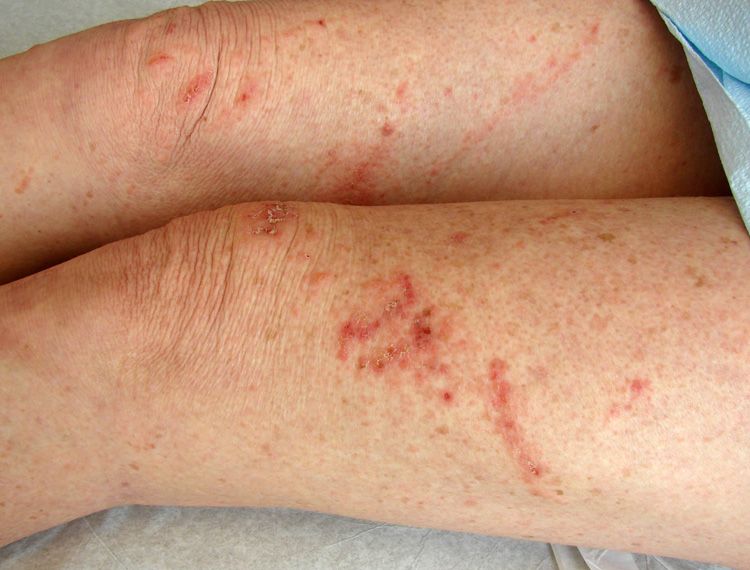
Image courtesy of Ted Rosen, MD.
Click here for the next image
Tick-borne illnesses occur most commonly in the late spring and summer months. The characteristic rash of Lyme disease, erythema migrans, often has a bull’s-eye appearance. Erythema migrans is seen in about 80% of patients with Lyme disease.
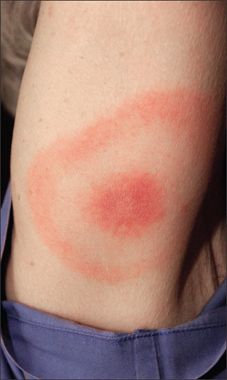
Image courtesy of CDC/James Gathany.
Click here for the next image
In early summer, an 8-year-old boy living in rural central Virginia was seen for evaluation of a rash on his buttock that had become pruritic. His father had removed a tick about 10 days earlier. The 4- x 2-cm lesion had 2 central papules with an outer ring in a figure-8 pattern (image A), consistent with 2 bites and 2 primary lesions, and appeared to be consistent with erythema migrans. The removed tick (image B) had a white spot on its dorsum, characteristic of Amblyomma americanum (Lone Star tick). This tick is not generally considered to be a vector for Borrelia burgdorferi, the spirochete responsible for Lyme disease, but it has been implicated as a cause of southern tick–associated rash illness.

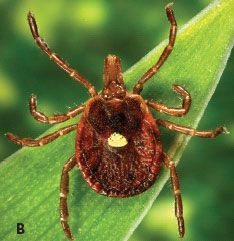
Image courtesy of Rebecca A. Shelton, MD and Julia C. Kistner, BS.
Click here for the next image
A 23-year-old man presented to an ED a week after the onset of headache, fever, chills, nausea, weakness, and malaise. Clinical findings included pale conjunctivae, jaundice, and tachycardia. There was no rash. A peripheral blood smear showed the parasite of tick-borne babesiosis (arrow). This disease is caused by the parasite Babesia microti and spread by the deer tick, Ixodes dammini, the same vector that transmits Lyme disease. Patients usually present with a high fever, chills, diaphoresis, and malaise.

Image courtesy of Gopi Rana-Mukkavilli, MD.
Click here for the next image
A 55-year-old truck driver in the rural Midwest was hospitalized with fever, headache, poor appetite, a blanching rash, and diffuse pain. Small red spots on his forearms and legs later spread to his trunk, palms, and soles. His wife had found a brown tick in his umbilicus a week earlier. This history strongly suggested Rocky Mountain spotted fever, the most frequently reported rickettsial disease in the United States. Most cases occur between April and September, the period associated with increased numbers of adult and nymphal ticks.
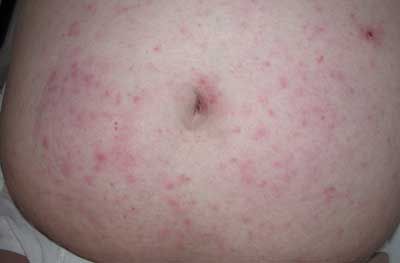
Image courtesy of Brett Mikeska, MD, and Sunil Patel, MD.
Click here for the next image
Brown recluse spider bites, most prevalent during the summertime, may result in deep, and slow healing ulcerations. This photo shows the “fiddleback” spider, Loxosceles reclusa, which displays a characteristic violin-shaped dark spot on the dorsal thorax. All of some 20 related species may produce necrotic skin lesions several days to weeks after a bite. This spider bites only in self-defense when its territory is intruded upon. The bite, initially painless, develops into exquisitely painful erythema and edema, followed by ischemic blister formation and, finally, well-demarcated gangrene.
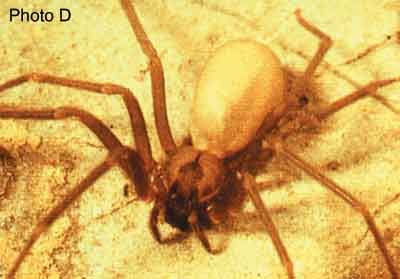
Image courtesy of Ted Rosen, MD.
Click here to return to the first image.
